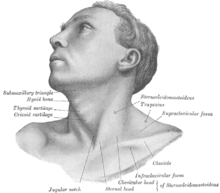| Torticollis | |
|---|---|
| Other names | Wry neck, crick in the neck, stiff neck, loxia |
 | |
| The muscles involved with torticollis | |
| Specialty | Orthopedics |
| Symptoms | Abnormal twisted position of the neck[1] |
| Usual onset | Any age[2] |
| Types | Variable, fixed[2] |
| Causes | Variable: Minor local injury, spasms of neck muscles, benign paroxysmal torticollis, certain medications, increased intracranial pressure, conversion disorder[3][2] Fixed: Congenital muscular torticollis, bone disorders, eye problems, brain injury, infections, scarring of the overlying skin[2][4] |
| Diagnostic method | By examination[4] |
| Differential diagnosis | Essential tremor, myasthenia gravis, multiple sclerosis, cerebral palsy[4] |
| Treatment | Ibuprofen, paracetamol (acetaminophen), heat, physiotherapy[3] |
| Frequency | 90% at some point[4] |
Torticollis, also known as wry neck, is an abnormal twisted position of the neck.[1] Most commonly the head is rotated to one side and flexed forwards, though other positions may occur.[4] Pain or fever may be present.[4] Depending on the underlying cause the condition may be short term or last years.[3][5]
Causes may be divided into variable and fixed.[2] Causes of the variable type includes minor local injury, spasms of neck muscles, benign paroxysmal torticollis, certain medications, increased intracranial pressure, and conversion disorder.[3][2] Causes of the fixed type include birth defects, including congenital muscular torticollis, bone disorders, eye problems, brain injury, infections, and scarring of the overlying skin.[2][4] Muscle spasms is the most common cause.[4] Diagnosis is generally by examination.[4]
When due to minor injury, often it will resolve after a few days, even without treatment.[3][6] Pain may be treated with ibuprofen or paracetamol (acetaminophen) and heat.[3] Other medications that may be used include benzodiazepines and botox.[4] Physical therapy may also be useful.[4] Certain causes may require surgery.[4][2]
Torticollis is common, with about 90% of people being affected at some point in time.[4] Females are affected more often than males.[4] About 4 in 1,000 are affected at birth, though it may occur at all ages.[4][2] The term torticollis is from the Latin tortus meaning "twisted" and collum meaning "neck".[7]
References edit
- ^ a b Dauer, W.; Burke, RE; Greene, P; Fahn, S (1998). "Current concepts on the clinical features, aetiology and management of idiopathic cervical dystonia". Brain. 121 (4): 547–60. doi:10.1093/brain/121.4.547. PMID 9577384.
- ^ a b c d e f g h i Tomczak, KK; Rosman, NP (March 2013). "Torticollis". Journal of child neurology. 28 (3): 365–78. doi:10.1177/0883073812469294. PMID 23271760.
- ^ a b c d e f "Neck pain - acute torticollis". NICE. September 2018. Retrieved 6 March 2021.
- ^ a b c d e f g h i j k l m n o Cunha, B; Tadi, P; Bragg, BN (January 2021). "Torticollis". PMID 30969679.
{{cite journal}}: Cite journal requires|journal=(help) - ^ "Dystonias Fact Sheet | National Institute of Neurological Disorders and Stroke". www.ninds.nih.gov. Retrieved 6 March 2021.
- ^ Bartleson, J. D.; Deen, H. Gordon (2009-07-23). Spine Disorders: Medical and Surgical Management. Cambridge University Press. p. 46. ISBN 9780521889414.
Many patients for no apparent reason will awaken in the morning with a "wry" neck or a "crick" in the neck. They may have trouble moving the neck and often have acute muscle spasm. Their pain and limited range of motion subside typically in a matter of a few days without or perhaps more quickly with treatment.
- ^ Cooperman, Daniel R. (1997). Karmel-Ross, Karen (ed.). The Differential Diagnosis of Torticollis in Children. Vol. 17. pp. 1–11. doi:10.1080/J006v17n02_01. ISBN 978-0-7890-0316-4.
{{cite book}}:|journal=ignored (help)